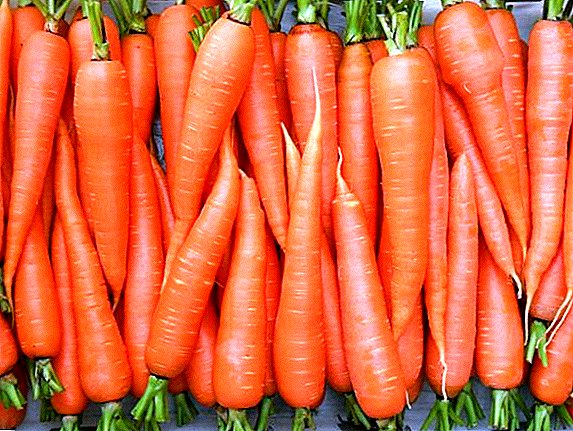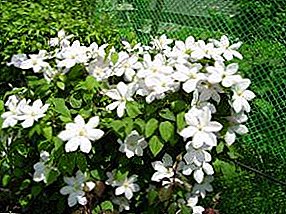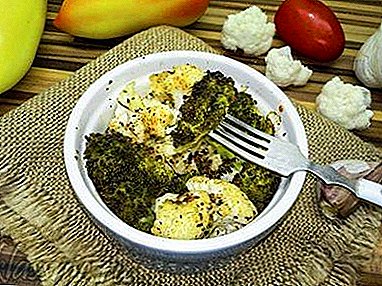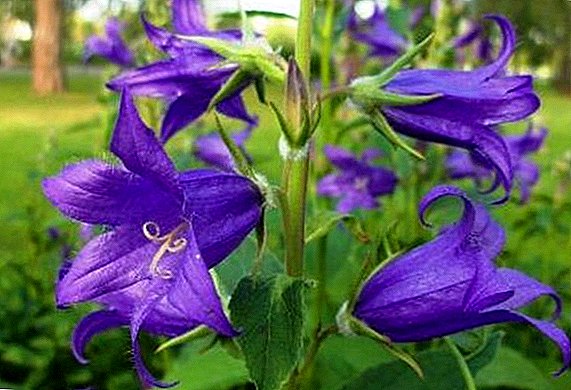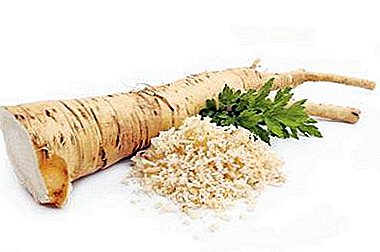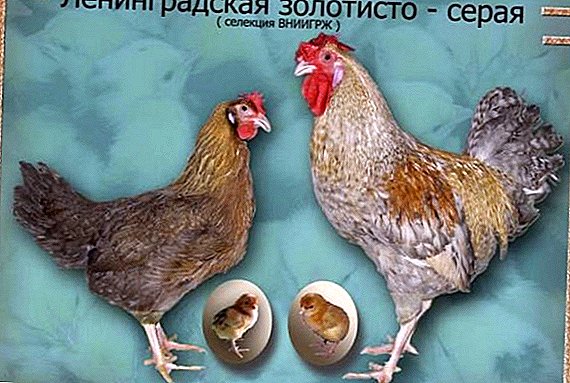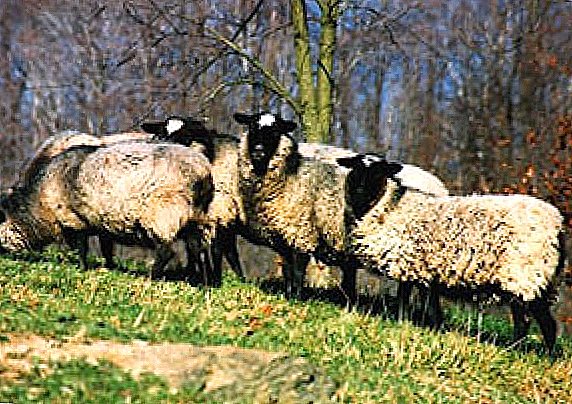 For all Slavic peoples, the main type of meat is pork, although even our great-grandfathers were very active in raising sheep. Attractive to the household, these animals are not even so much because of the meat, but from their beautiful, luxuriant and warm fleece.
For all Slavic peoples, the main type of meat is pork, although even our great-grandfathers were very active in raising sheep. Attractive to the household, these animals are not even so much because of the meat, but from their beautiful, luxuriant and warm fleece.
Also, in the past, sheep skin was also of great value, which can warm even in the most severe frosts. Although in the modern world all this has a completely different relevance, but still many livestock breeders want to keep and breed sheep.. Below we will acquaint you in detail with one of the most popular breeds of these animals, which is called Romanovskaya.
What are the features and distinctive features of the representatives of the Romanov breed?
 The breed appeared with the help of selection, however, not due to the efforts of specially trained scientists, but in the process of long-term keeping of individuals of sheep by ordinary peasants. Smart and experienced livestock breeders to whom this skill has been transmitted by many generations knew that in order to improve the performance of sheep, it is necessary to interbreed the largest and healthiest individuals among themselves. Actually, this principle lay in the breeding of a new breed, which is still famous not only for its meat qualities, but also for its good fleece.
The breed appeared with the help of selection, however, not due to the efforts of specially trained scientists, but in the process of long-term keeping of individuals of sheep by ordinary peasants. Smart and experienced livestock breeders to whom this skill has been transmitted by many generations knew that in order to improve the performance of sheep, it is necessary to interbreed the largest and healthiest individuals among themselves. Actually, this principle lay in the breeding of a new breed, which is still famous not only for its meat qualities, but also for its good fleece.
To earn the trust of ordinary peasants is quite difficult, but to earn it from experienced professionals is not an easy task at all. But the Romanov breed of sheep succeeded because it has a very large number of merits:
Individuals of this breed are representatives of the universal direction of productivity. Both mutton and sheepskin are valuable to consumers. After all, Romanov sheep meat is not only very tasty and fragrant, but also considered very useful (in principle, lamb is usually referred to as the most pure and dietary meat, which is why Muslims eat it). But the dignity of sheepskin is not only a beautiful color, but also the coarseness of the wool itself, which significantly improves its quality.
 High adaptability of sheep to the most diverse conditions of climate and content. This breed is considered to be the representative of the Northern regions of Russia, but it is very well suited for breeding in the middle zone.
High adaptability of sheep to the most diverse conditions of climate and content. This breed is considered to be the representative of the Northern regions of Russia, but it is very well suited for breeding in the middle zone.
The unpretentiousness of animals, their ability to eat the simplest food and to gain weight is quite significant. Very resistant to tolerate low temperatures. Moreover, walking outdoors in the winter is very good for the health of animals and their performance.
The breed is very well able to play independently. Moreover, this process can even be called intensive, since most of the queens have the ability to produce offspring twice a year. The appearance of sex-hunting in the Romanov sheep does not depend at all on the seasonality and the ewes are rather precocious, since their first fertilization can occur before the age of 1 year. Moreover, two to five lambs can be born at a time.
Rams can be easily kept and grazed along with the entire flock, but it is best to keep only one male in one flock, since they can compete very aggressively with each other. Most often, the sheep allowed for meat at a young age, sometimes even in the dairy.
Does the breed have flaws and what are they?
The disadvantages of the Romanovs sheep can be attributed only to the fact that not very productive individuals can sometimes be found among them. Especially often this happens when, over a long period, representatives of one genus intersect with each other. Also, the multiplicity of ewes does not always play a positive role, since such litters are very exhausting and as a result very weak, requiring care, lambs are born.
The special characteristics of the Romanov sheep that distinguish them from other breeds
 One of the most important characteristics of any breed of sheep is the color of their wool. Romanov lambs are usually born black, although on the head the limbs and the tip of the tail must have white spots. This color is created by the black awn, which by about 1 month begins to outgrow the white fluff, causing the lambs to become gray. Gradually, they become even lighter and by the age of 5 months the color of their wool can hardly be called light gray, as it becomes almost completely light.
One of the most important characteristics of any breed of sheep is the color of their wool. Romanov lambs are usually born black, although on the head the limbs and the tip of the tail must have white spots. This color is created by the black awn, which by about 1 month begins to outgrow the white fluff, causing the lambs to become gray. Gradually, they become even lighter and by the age of 5 months the color of their wool can hardly be called light gray, as it becomes almost completely light.
The only peculiarity is the red or golden tips of the wool, which the representatives of the breed have for quite a long period of time. But by adulthood, the fleece of Romanov sheep becomes completely gray, with a characteristic steel tint.
A very important feature of the representatives of this breed is that in the middle of it there are three varieties. They differ in the type of body build - strong, rough or delicate. It is possible to determine what type of individual an individual can be according to the characteristics of the external exterior and the characteristics of the skin and wool. And if such a task may seem very difficult for an average person, one glance at an animal will be enough for a professional shepherd. In particular, the focus is on such criteria:
Sheep with a strong type of bones differ in the most optimal ratio of indicators such as fecundity of females and viability of all individuals. External features of this type are proportionally developed all parts of the body, which is evidence of the quality of the animal. Such individuals are characterized by a wide I and a very deep chest, which also has a large girth.
 The backbone of them, respectively, strong, but the skin, although dense, but very thin and elastic. As for wool, in individuals with a strong type of bones it is most often thick and leveled, which is the main sign of quality. when deploying a sheepskin of Romanov sheep, it will have a gray color, since the ratio of more gray to white fluff has such an indicator as 1:4-1:10: The length of the spine can reach 2-3.5 centimeters, and the down - 5-6. An adult sheep of this breed is characterized by a black mane.
The backbone of them, respectively, strong, but the skin, although dense, but very thin and elastic. As for wool, in individuals with a strong type of bones it is most often thick and leveled, which is the main sign of quality. when deploying a sheepskin of Romanov sheep, it will have a gray color, since the ratio of more gray to white fluff has such an indicator as 1:4-1:10: The length of the spine can reach 2-3.5 centimeters, and the down - 5-6. An adult sheep of this breed is characterized by a black mane.
Representatives of the coarse type of Romanov sheep have heavier bones, and the wool is more dense and consists of hard villi. Unlike the previous type, their awn is much thicker and often in length it is well ahead of down. The quantitative ratio of bone and fluff is 1: 4. The fleece consists of a larger amount of transitional fiber, which, when deployed, makes it very dark, almost black. And in general, the color of sheep of a rough type has dark gray shades. Also, animals are characterized by a large and rough mane.
The mane is also characteristic of ewes, only their spines are much longer than the down, especially on the back and sides. It is worth paying attention to the peculiarities of the skin of a rough type of sheep: it is more coarse, dense and not so elastic, it does not respond so well. Although the described type of Romanov sheep is very common, their sheepskin is not so valuable because it is coarser, heavier and not quite beautiful.
Romanov sheep of the gentle type have a very large number of very curved down in their rune, the advantage of which over the awn is 11: 1. Moreover, the spine itself is very thin in its structure, therefore the unfolded sheepskin in this type of animal has a light color. Since there is very little backing hair in the rune, the thin down falls down, lowering the quality of the sheepskin. For this reason, such animals are not used for breeding, because they get very little wool, and for obtaining meat it is more profitable to breed other sheep breeds.
It is worth noting that this type of tender is also called through the underdeveloped backbone with a sharp withers and a slightly drooping sacrum. Their thorax is also narrow, with interception behind the shoulder blades, the legs are set very close to each other. The head of these animals has a long and narrow shape. But the biggest drawback of the Romanov sheep of the gentle type is considered to be their reduced productivity (both in wool and meat) and poor viability of both newborns and adults.
How high is the productivity of the breed when it is bred at home
Speaking about productivity, first of all we will pay attention to the weight of Romanov sheep and the amount of meat produced. Most of all in size and heavier in weight are sheep, insemination, the weight of which very often reaches 75 kilograms. Ewes weigh a little less - from 50 to 55 kilograms. But how much the lambs will weigh at birth will directly depend on their number in one litter. On average, it can be like this:
- At birth, one lamb, its live weight can be equal to 3.7 kilograms.
- The live weight of lambs born in twins is usually 2.9 kilograms.
- Triplets of Romanov sheep are usually born with a weight of 2.5 kilograms.
- At birth, immediately four lambs weight of each usually does not exceed the figure of 2.3 kilograms.
But, whatever the weight of a lamb born, when fattening with mother's milk, it gains weight very quickly. On the hundredth day of life, they usually weigh between 16 (with multiple litter) and 25 (in small litter) kilograms. Even with the use of moderate fattening, the average daily gain in live weight is usually 140-170 grams. Already in 6-7 months the baranchiki weigh about 35 kilograms.
Thus, with a large weight of an animal, its meat productivity is also large. Romanov sheep are famous for very good quality meat, the taste and aroma of which are characteristic only of this breed. When slaughtering sheep at the age of 7 months, indicators of their productivity usually reach:
- Live weight at this age is on average 40 kilograms.
- The mass of carcass at the exit is 18.4 kilograms.
- The flesh of one ink on average weighs 11 kilograms.
- All bones of an animal have a mass of 3.7 kilograms.
 As for the fleece of the Romanov breed, it has the best indicators for the majority of representatives. First of all, they have a very correct ratio of the number of awn and down - 1: 4-1: 10. This characteristic is even used in the breeding of animals.
As for the fleece of the Romanov breed, it has the best indicators for the majority of representatives. First of all, they have a very correct ratio of the number of awn and down - 1: 4-1: 10. This characteristic is even used in the breeding of animals.
Experienced livestock breeders recommend selecting those individuals in which this ratio is 1: 7, which gives the sheepskin a bluish tint and overall high aesthetic characteristics. It should also be noted that for the described breed too light or reddish shade of wool is considered unacceptable.
However, no matter how good the sheepskin in Romanov sheep, it is important to observe the following rules of her haircut and further use:
Sheepskin for clothing should be chosen with the lack of a significant amount of fluff, otherwise when wearing it will fold and clump together.
A very short down (up to 6 centimeters) is usually not lumpy and is warmer. Therefore, soft-bonded sheep are cut more often.
Sheepskin with a large amount of guard hair does not have high thermal characteristics, heavier in weight.
The fleece, which was cut from young sheep, at the age of 5-6 months, is very much appreciated. Such a sheepskin even has its own name - Petrovskaya. The fact is that the down in such a sheepskin has not only a good length, but also the necessary thickness, silkiness. The presence of animals of this age is also more subtle.
In general, Romanov sheep are recommended to cut 3 times a year. The amount of wool that can be obtained from them will depend significantly on the sex and age of the animals. On average per year from one animal you can get from 1.1 to 1.3 kilograms of rune. The amount of pure sheepskin at the exit is usually from 65 to 80%.
How important it is to provide care for Romanov sheep: rules for breeding and keeping animals at home
 In thorough care, Romanov sheep are not required. It is very easy to breed them, okoki occur very often and it is very easy for ewes. Fertility occurs in almost 100% of cases. Lambs are born healthy, although not always strong (especially in numerous litters). It is very difficult for such animals to adapt, so they often have to be cared for.
In thorough care, Romanov sheep are not required. It is very easy to breed them, okoki occur very often and it is very easy for ewes. Fertility occurs in almost 100% of cases. Lambs are born healthy, although not always strong (especially in numerous litters). It is very difficult for such animals to adapt, so they often have to be cared for.
The fact is that an ewe is able to feed offspring with its own milk of no more than 4 lambs, but if there are more of them, there will not be enough milk for everyone. However, newborns are able to drink even cow's milk without problems, which, however, is not as valuable to them as mother milk.
Another very important aspect of care is the construction of a stall of the required size. After all, sheep are very mobile animals, and on summer pastures they travel long distances in a day. Therefore, in the winter they need a lot of space for movement, especially if the flock is numerous. In addition to space, animals will also need troughs and drinkers, the number of which must be calculated according to the number of individuals. Do not forget about the litter, which can serve as straw or hay.
Features of the diet of sheep at different times of the year
It is very important to know that the feeding of Romanov sheep is very dependent on the time of year. After all, in winter they are usually kept in a stall, letting them go for short walks. In the summer, they are free on grazing almost all day, sometimes even spend the night under the open sky or with special sheds. Consider the features of each period.
In summer, sheep are kept on pastures. However, livestock breeders recommend transferring animals to succulent feeds gradually, giving hay and concentrates for 1-2 weeks. Artificial pastures for them is best sown with cereal or leguminous plants. Animals can graze on them from early spring to frost. It is important not to forget about the watering, to which the sheep should be driven away in the morning and evening. It is best that these sheep drink either well or clean river water.
Bad pastures are floodplain, marshy or wooded meadows. In hot weather, it is impossible to keep sheep in the open area, as they are very poorly tolerated by high temperatures. It is better to take them to shady places or under a shed.
During the nomad season, hay is the main product of sheep diet. Besides him, these animals can be fed with such rough feeds as straw, chaff and branch feed. However, it is important to give them juicy concentrates, which are silage and various root vegetables. Animals are given only in a crushed form and only in the feeders, otherwise they will be trampled under their feet. Additionally, it is important to feed the sheep with urea and mineral supplements. Romanov breed is not recommended to give mealy feed, because of their contaminated wool.


